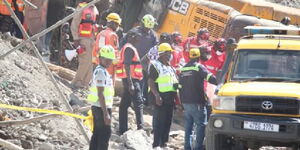Nairobi's ties to the freemasonry world are well documented with some of its posh estates known to have been built by the society's members. However, the 'why' behind the highly secretive organization's decision to leave its mark across the Kenyan capital has not been examined.
A quick walk around the capital city and one can’t miss the uniqueness of buildings that were erected by Freemasons who put up structures like the All Saint’s Cathedral in the early years of the 20th century.
According to historical records, the secretive society put up churches as well as colonial institutions and extensively incorporated their signs and symbols even in Anglican churches.
Indeed, it was the Freemasons who defined Nairobi’s early architecture, building some of the grandest buildings in the country to date.
The name “Nairobi” comes from the Maasai phrase 'Enkare Nyrobi' which translates to the place with “cool waters”. The area Nairobi currently occupies was essentially an uninhabited swamp until a supply depot of the Uganda Railway was built by the British in 1899 linking Mombasa to Uganda.
Once the Kenya Uganda Railway was completed, in 1901 – exploiting cheap labour from British India, as well as the Africans themselves – the headquarters of the railroad were moved from Mombasa to Nairobi.
That is how the city of Nairobi was born, and its development was very rapid owing to the railroad. The city was founded as a depot for railway supplies, due to its central location between the coast and the British properties in Uganda.
This area was set apart not only for its strategic position; it was also characterised by an extremely hospitable atmosphere determined by its proximity to a thick hydrological network. This provided an abundant presence of water, and by its high altitude position, between 1600 and 1800 meters above sea level, which generates cool temperatures and eliminates the risk of tropical diseases like malaria.
Subsequently, Nairobi began to develop as the economic and commercial centre of the British protectorate and was proclaimed as its capital in 1901.
What the early planners didn't realise was how popular Nairobi's elevated position and abundant water supply would prove to be with settlers, who flocked there to erect properties where they could.
During the stewardship of the Imperial British East Africa Company (IBEA), under William Mackinnon from 1887–1895, the commissioner expropriated land technically by invoking the Foreign Jurisdiction Act of 1890.
This Act promulgated the East African Lands Order which “legally” guided these land seizures that followed after the building of the railway, from 1896 to 1901.
At the time (1901), a man known as John Ainsworth (a member of the freemason society), was the Nairobi sub commissioner or an equivalent of a District Commissioner or County Commissioner. The natives had nicknamed him Lord Muthaiga.
Charged with the young town development, Ainsworth is said to have sought the aid of his colleagues in the secretive masonic society.
It was Ainsworth who is said to have given huge parcels of land to a shrewd businessman known as Ewart Grogan.
In one of the parcels located in present-day Muthaiga, Grogan built an all-white hospital that still has some Freemason architectural influence.
He named it after his wife Gertrude maybe as a way of expressing the much struggle he had to go through to fully win her heart. It is today a famous children's hospital called Gertrude Children Hospital.
By this time, the Nairobi Townscape had already taken shape and developing at an unprecedented pace.
The architectural planning of Government institutions was purely influenced by Freemasons who were brought into the country by Grand Master Temple Moore, the only known Freemason Architect available around that time in 1917.
It is evident that the Freemasons defined Nairobi’s early Architecture, and all the strong and unique buildings found all over Kenya have masonry influence. All are classical Gothic, Medieval, and Roman architecture combined and even national monuments around the city were crafted by masons.
That explains why Nairobi City has a colonial identity similar to cities found elsewhere around the world that were constructed by members of the Freemasons Society.
Sir Herbert Baker (1862-1946), a Freemason, took charge of several projects in the growing city including exclusive schools for Europeans only. Nairobi Primary and Prince of Wales (Nairobi School) were such among many others.
The layout and designs of Nairobi's early shops and buildings were borrowed from Washington DC, Paris London, Cape Town, Pretoria, New Delhi India, and La Plata, a city in Argentina.
Most of the mentioned cities were constructed by men who were not in a hurry as the finished product was so articulate and remain in mint condition to date.
The city's architecture was designed and constructed by skilled masons, who had a clear knowledge of Freemason Egyptian-like signs and symbols.
Some of the buildings in Nairobi built by Freemasons are, Parliament, the All Saint’s Cathedral, McMillan Library, Kipande House, Pan Africa House, National Archives, State House, Kenya Railways headquarters, High Court, and City Hall, all of which stand out for their impeccable, timeless and articulate seamless masonry.
Interestingly, there are rumors that there used to be a tunnel that is connected to State House from the All Saints Cathedral Church basement and the same continues to Defense Headquarters and even to the Anglican Church residence opposite State House. Whether the tunnels exist is anybody’s guess.
The group of highly skilled masons was ushered into Kenya due to their world-famous genius in bricklaying, stone carving, and meticulous construction that is evident to date.
Nairobi's iconic buildings turned the former railway stop into one of the most recognizable cities in the world and inspired the contemporary buildings which have made the city a major trade hub for East and Central Africa.












